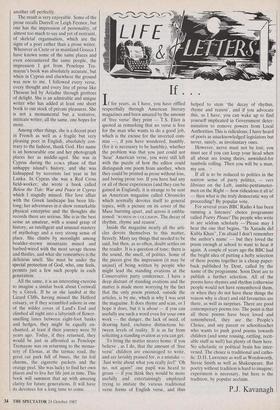Grottoes of delight
Peter Levi
UNDER HELICON by Penelope Tremayne
Tabb House, £9.95
This is a book about Mediterranean places; its author is courageous, high- spirited and wise, but the individual com- ponents of the book, the brief pages of prose, the unpretentious poems and the splendid photographs, would none of them stand so well alone. Under Helicon is therefore not just unique and haunting but a triumph of originality in book design. This must, I imagine, be due to Penelope Tremayne herself. Most of the photo- graphs are by Guy Gravett and the book production appears to be partly by Robert Hartnoll and partly by Quintrell of Wade- bridge. A foreword by A.L. Rowse adds to the strong flavour of Cornwall that arises from these clues. Whoever was responsi- ble, this is a highly distinguished piece of book production, the most interesting that I remember since the co-operation of John Berger and Jean Mohr some 20 years ago. The verse, the photographs and the prose passages lead into one another and set one another off perfectly.
The result is very enjoyable. Some of the prose recalls Durrell or Leigh Fermor, but one has the impression of personality, of almost too much to say and yet of restraint, of skeletal organisation, which are the signs of a poet rather than a prose writer. Wherever in Crete or in mainland Greece I have known some of the same places and even encountered the same people, the impression I got from Penelope Tre- mayne's book was absolutely accurate, but when in Cyprus and elsewhere the ground was new to me. I followed every verse, every thought and every line of prose like Theseus led by Ariadne through grottoes of delight. She is an admirable and unique writer who has added at least one short book to our stock of private pleasures. She is not a monumental but a tentative, intricate writer; all the same, one hopes for more.
Among other things, she is a decent poet in French as well as a fragile but very pleasing poet in English, absolutely con- trary to the fashion, thank God. Her name is an honourable one and her photograph places her as middle-aged. She was in Cyprus during the EOKA phase of that unhappy island's history, and she was kidnapped by terrorists last year in Sri Lanka. In Cyprus she was a Red Cross field-worker; she wrote a book called Below the Tide: War and Peace in Cyprus which I stupidly missed. Her love affair with the Greek landscape has been life- long; her adventures in it show remarkable physical enterprise and the thoughts she records there are serious. She is in the best sense an amateur, with a sound grasp of history, an intelligent and unusual mastery of mythology and a very strong sense of place. She climbs by moonlight among boulder-strewn mountains mined and barbed-wired with the most savage thorns and thistles, and what she remembers is the delicious smell. She must be under the special protection of God, who, one feels, permits just a few such people in each generation.
All the same, it is an interesting exercise to imagine a similar book about Cornwall by a Greek. If he or she landed at the Lizard Cliffs, having missed the Helford estuary, or if they scrambled ashore in one of the wilder coves of Land's End and climbed all night into a labyrinth of flower- smelling lanes between eight-foot banks and hedges, they might be equally en- chanted, at least if their journey were 50 years ago. Today, if they returned, they would be just as affronted as Penelope Tremayne was on returning to the monas- tery of Elonas, at the tarmac road, the great car park full of buses, the tin foil charms, the cigarette packets and the orange peel. She was lucky to find her own places and to live her life just in time. This book will summon that up with amazing clarity for future generations. It will have its devotees for a long time to come.



















































 Previous page
Previous page